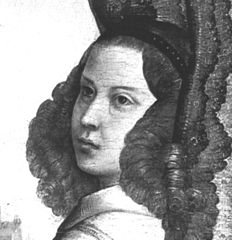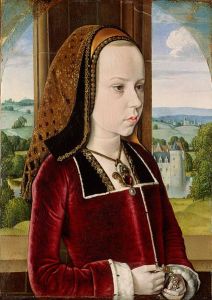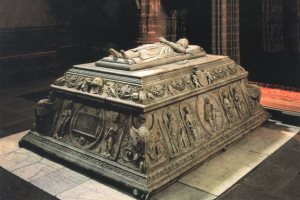
I’ve been reading a bit of Spanish history lately, researching the life of Queen Isabella of Castile. She had a considerable number of children, however only one male child survived. He was named Juan after his paternal and maternal grandfathers as well as the patron saints of his parents. Interestingly enough, the Spanish have an equivalent to the English Prince of Wales. The heir to the Spanish throne is called Prince of Asturias, a small principality in north-west Spain.
Prince Juan was born on June 30, 1478 in Seville. He was the son of Queen Isabella I of Castile and King Ferdinand II of Aragon. The long desired male heir to both his parents thrones, he was born eight years after the delivery of their first child Isabella and his birth was considered nothing short of miraculous with the city engaging in wild and energetic celebrations for three days. His mother would always call him her “angel” and indeed he looked like one with his blond hair and delicate facial features.
A little over a week after Juan was born, a splendid procession made its way through the streets of Seville from the palace to the cathedral. Juan’s nurse carried him on a mule with a velvet saddle under a brocade canopy. He was wrapped in a brocade cloth and eight city officials dressed in black velvet cloaks surrounded him. Three pages followed in the procession carrying gifts and gold coins. Beautifully dressed courtiers lined the street and clerics held up silver crosses. The archbishop of Seville officiated the baptismal service. Musicians played drums, trumpets and flutes to welcome the infant.
A month later an even more elaborate ceremony was observed, this time including the Queen in the procession, elegantly dressed in a bejeweled gown covered in pearls on a white trotter with a saddle encrusted with gold and silver. She attended high mass at the main altar of the church, surrounded by Castile’s highest ranking courtiers. There were prayers for the mother’s survival and the sustained good health of the child.
Juan was given his own household and the members were judiciously chosen by Isabella as they were in charge of his moral guidance, education and development. His wet nurse was Maria de Guzman, a member of the powerful House of Mendoza. His first tutor was the Dominican Fray Diego Deza who taught theology at the University of Salamanca. Later, Isabella appointed the Italian humanist Peter Martyr d’Anghiera.
Juan’s parents were affectionate but demanding. His health was always delicate, something that was of great concern to them. Isabella monitored his diet. Doctors visited him every morning and reported back on his digestion and bodily functions and how he had slept. The Queen would send him treats such as lemon blossom candies, strawberry conserves, other sweets and jars of quince meat. One chronicler reported that Juan was unable to speak plainly because of an impediment of his lower lip and tongue.
He was expected to maintain an immaculate and impressive appearance. He wore the most ostentatious apparel to show his high rank and to impress ambassadors and visitors to the court. A hierarchy of servants followed a strict protocol in dressing and undressing Juan. He ordered two new pairs of shoes a month and two new pairs of slippers each week and had to wear a new belt every day. He was allowed to wear each outfit three times before giving them away to household staff on a rotating schedule. Queen Isabella became angry when she learned that Juan and his sister Juana were putting aside favorite articles rather than giving them away. The children also were required to give excess food to the servants. Isabella was teaching them to be generous and just with these practices.
He received the usual court education in the classics as well as instruction and training in court ritual, how to rule and the art of self-preservation. Isabella arranged Juan’s daily routine. In the morning there were prayers with his tutor, then mass followed by lessons. Juan loved music and during his two hour rest period during the day, the Queen would send her music master with three or four choirboys to sing to him. He had his own musicians and played several instruments. Isabella invited sons of aristocrats to live and learn with the prince. This included the two sons of the Genoese explorer Christopher Columbus, Diego and Ferdinand. They lived at court as pages to the prince and later to Queen Isabella herself and became great friends of Juan.
There was a master who taught Juan proficiency of arms. He slept with a sword at the head of his bed and was instructed how to use it. He was taught to ride, joust, hawk and hunt, play chess and cards and to sing and recite poetry. He corresponded with humanists and poets. He also attended a wrestling school. His tutor Peter Martyr described Juan as sensitive and scholarly with great potential but not strong. By the time he was fifteen, his household consisted of eighty-two members and by age eighteen, it was even bigger.
There is an account that indicates how the Inquisition affected the everyday lives of people, even at court. One day in the 1480’s, Prince Juan and his pages were playing “Inquisition”. There was a drawing of lots to determine who would be the judges and who would be the victims. The judges proceeded to read the sentences. Those who were condemned were stripped of their clothes and tied to stakes. An older page realized things had gone too far and ran to the queen’s apartments, interrupting her siesta. She hiked up her skirts and ran to Juan’s quarters, finding the boys garroting their victims. She struck Juan and then untied the boys, bearing them off wrapped in capes.
Juan traveled frequently. Shortly after his birth, his parents took him to the Cortes of Toledo where he appeared with them at the high altar of the cathedral. The members of the Cortes swore an oath of fealty to him as the heir to Isabella and Ferdinand’s kingdoms. In the fall of 1487, Juan accompanied his parents to Aragon where they held Cortes in Zaragoza after stopping on the way to be entertained in Guadalajara. In the fall of 1489, he appeared in front of English ambassadors dressed in rich crimson velvet.
While Isabella and Ferdinand waged the Granada War, Juan made several appearances. He accompanied his mother on the entry to Jaen after it was conquered. His father knighted him before the siege of Granada in June of 1491. He was given a helmet, a coat of mail, campaign breeches and a dagger as well as a horse and armor. He was now able to accompany his father on expeditions and knight other nobles. When Granada finally fell on January 2, 1492, all three of them entered the city together. The keys of the city were passed first to Ferdinand, then to Isabella and finally to Juan.
In 1495, Isabella sent Juan to the French frontier as her representative. That same year, an important alliance was made with the Habsburgs. Juan was to marry Margaret of Austria and his sister Juana was to marry Margaret’s brother Philip, known as the “Handsome”. Juana was to marry first and sailed for Flanders. A few months after Juana’s arrival in Flanders, these same ships brought Margaret back to Spain for her marriage to Juan. She experienced severe weather on the journey and after a near shipwreck, she arrived in Santander on March 8, 1497. She had a large entourage and the first carriages ever seen in Spain. Juan and his father rushed to greet her. She tried to kiss their hands but they embraced her lovingly. They accompanied her to Burgos where she was greeted and embraced by Queen Isabella.

Margaret was a sensation and drew crowds wherever she went. The wedding took place on Palm Sunday, April 3, 1497 and Margaret received copious gifts. Everyone in the family adored Margaret. She was praised by Ferdinand and shared many interests with Queen Isabella.
Juan and Margaret were in love. He revered her and there was so much lovemaking, the doctors advised Juan’s parents the couple should be separated to spare his health. But Isabella was happy they were in love and didn’t intervene and Margaret was soon pregnant. Juan and Margaret had received the city of Salamanca as a marital gift and they traveled to live there. When the couple arrived in their new home they were triumphantly received.
Queen Isabella had arranged a marriage for her eldest daughter Isabella with King Manuel of Portugal. Isabella, Ferdinand and their daughter stopped in Salamanca to visit Juan and Margaret on their way to the wedding. As they traveled on, a speedy messenger caught up with them with the news that Juan had fallen critically ill. The Bishop of Salamanca wrote Juan had been happy a few days before but had weakened and lost his appetite. He indicated it was so serious, they had called the Queen’s doctor and other physicians and begged Ferdinand and Isabella to come. Isabella was greatly involved in the Portuguese wedding preparations so Ferdinand rushed to Juan’s side. He found Juan pale but lucid.
Ferdinand sent conflicting messages to Isabella about the state of Juan’s condition, knowing that he was dying. Juan had been weak and sick in the past with stomach trouble and was quick to accept his fate. He attempted to comfort his father who was pleading with him to live. Juan’s final request, after asking his parents to care for his pregnant wife and unborn child, was to ask that money from his estate be used to free Christian captives in Muslim lands. He perished from tuberculosis on October 4, 1497.

Juan was buried in Salamanca but was later transferred to Avila where he had requested to be buried. Margaret was prostrate with grief and fell seriously ill. Queen Isabella rushed to her side, personally nursing her back to health. Margaret credited Isabella with saving her life. However, Margaret’s child was born premature. The news of the death of Juan and his heir spread across Europe and his parents were in deep mourning. Margaret stayed in Spain for some time with Queen Isabella before returning to Flanders. Juan’s death was a sad tragedy. His elder sister Isabella died in 1498, leaving their sister Juana as the heir to the Spanish throne. She would come to be known as Juana la Loca, “the Mad”.
A post script to the story of Prince Juan: When Juan was two years old, Ferdinand announced his intention to pay for construction of a monument in Rome to fulfill a vow he had made to build a church in honor of Saint Peter. The Tempietto (small temple) was built on the site where Ferdinand and Isabella believed Saint Peter had been crucified in 64 AD. It remains one of the masterpieces of High Renaissance architecture and was the Spanish royal family’s way of giving thanks for the gift of a son.

Further reading: “Isabella: The Warrior Queen” by Kirstin Downey, “Isabel the Queen: Life and Times” by Peggy Liss
[…] children, Philip the Handsome and Margaret of Austria were to marry King Ferdinand’s children, Juan, Prince of Asturias and […]
LikeLike
It is interesting how Prince Juan was born to Isabella of Castile and Ferdinand of Aragon after eight years after the birth of the Infanta Isabella, the one who wed with Manuel of Portugal and she was the mother of Prince Miguel who was heir to Castile, Aragon and Portugal. Prince Juan was a very interesting historical character. If only he had lived, there would have been no Hapsburgs in Castile or Aragon and Juana of Castile would never have become Queen. She would probably have remained in Flanders.
LikeLike
[…] Juan was the only surviving son of Queen Isabel of Castile and Ferdinand of Aragon. He was born in 1478 in Seville and was given a classical education and taught martial arts. He enjoyed music and wore sumptuous clothing. His parents were loving but demanding. Juan’s health was always fragile, a cause of great concern to his parents. […]
LikeLike
[…] have heard of the early demise of prospective monarchs such as Arthur Tudor, Prince of Wales, Juan, Prince of Asturias or Henry Frederick, Prince of Wales. These young men displayed potential as kings and died too […]
LikeLike
Thank you Susan!! I enjoy reading about this great Prince!! I think he was great !!
LikeLike
A good description of our cried prince. Thank you Susan, I would just like to add the rest of your real titles, Juan de Aragón and Castilla. Prince of Asturias and Gerona, Duke of Montblanch, Earl of Cervera and Lord of Balaguer and Salamanca.
LikeLike
terrific telling of this heir’s tale, Susan!
LikeLike
Thanks rufus!
LikeLike
What a sad story, but a great picture of life in that age among the aristocracy. Have you ever watched “The Other 1492?” It taught me quite a bit about Spanish History. Thanks Susan
LikeLike
Very interesting! I knew bits and pieces of the stories of this family, but you put it all together. Life was precarious even for the very wealthy and powerful.
LikeLike